In the 1960s, teen fashion underwent significant changes, reflecting the evolving social and cultural dynamics of the era.
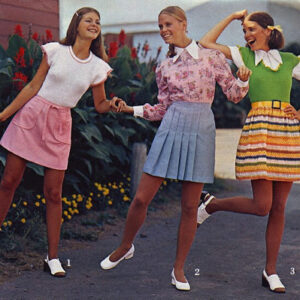
School Dress Code
I graduated from high school in 1968. We had a Dean of Girls who was relentless about skirt length. If you knelt and your skirt didn’t touch the ground, she’d fix that. She’d cut the hem out, making it longer. If that wasn’t sufficient for decency, you were sent home.
No pants or shorts allowed in school. And I don’t know what awful thing would have happened to you if you dared to wear jeans.
Teen clothing during the 1960s was influenced by the prevailing conservatism of the period. Many high schools had strict dress codes. For girls, skirt length was a contentious issue. Hemlines typically hovered just above the knee, and schools often enforced this rule rigorously. A Dean of Girls might even lengthen a skirt’s hemline if it didn’t meet the prescribed standards. Pants and shorts were generally not allowed in school, and wearing jeans would have been considered a violation of the dress code.
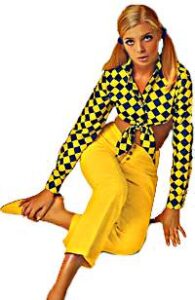
Okay, today that behavior would get her arrested, but the simple truth was that high school in the 1960s was conservative.
Friday Dress Code
On Fridays, many schools had a tradition of wearing school colors. For girls, this meant donning blue skirts and white blouses, while boys wore blue slacks with white shirts. This practice was a nod to school spirit and tradition.
That’s not what you want to hear, and it isn’t what you see in the movies, but I was there and I know :>)

Sears 1966 Shirt – Bermuda collared broadcloth of Dacron polyester and cotton. May be worn in or out. $3.94 Sweater – Cable stitched sweater of wool knit. Cardigan style. $11.94 Skirt – A-line skirt in wool woven plaid. No waistband. $9.94 Socks – Cable stitched knee socks of wool and stretch nylon. $1.88
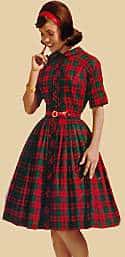
Montgomery Ward 1964 Plaid and pretty, styled along classic lines in soft 33% wool 33% nylon, 33% acrylic. $10.87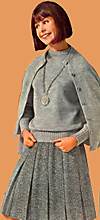
New Look Classics in virgin Turbo Orlon acrylic. Saddle shoulder, crew neck style. Grosgrain trim on cardigan closing. $4.97 Hip stitched 12 box-pleated skirt. J.P. Stevens wool herringbone tweed. $7.97
Casual Wear for Social Occasions
For social occasions and outings, teens had more freedom to express themselves through fashion. Dresses became shorter and more playful. Shift dresses with patterns and A-line skirts came into vogue. These dresses were often characterized by shorter hemlines, typically about two inches above the knee. Sleeveless sweater dresses and knitwear were popular choices for social events.
For social occasions you could wear your skirt length shorter than what was acceptable at school. The dresses are light and fun.Penneys 1968Glenbrooke Jr Smart Knits – Magnetic mixers of acetate and rayon double knit. Striped shift with button trim placket. 2 inches above the knee. Short sleeves, jewel neck. $10.97Sears 1968Sleeveless sweater dress, acetate knit. White bodice, blue and green striped skirt. Turtleneck, daisy pin. $10.97
Pull on style sweater dress of feather light Winsock yarn of Orlon acrylic. Basket weave stitched yoke. $9.97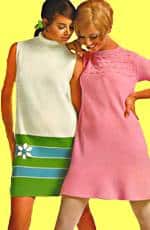
Hip Huggers
Hip huggers were a trendy style in the 1960s. These pants were low-slung and typically worn with wide belts. They had a slimming effect and were favored for their fashionable look. Hip-hugger pants were paired with short-sleeve “boy” tops and tank tops, creating a casual and stylish ensemble.
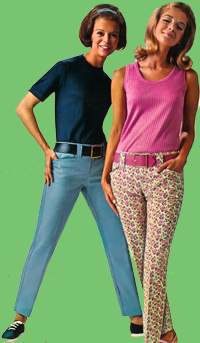
Montgomery Ward 1967 Low slung straight legged pants in cotton denim or print. Wide contour belts with big metal buckle.
Short sleeve “boy” top. Cotton double knit. $2.99 Cotton denim solid color pants. Leather like belt. Sanforized too, maximum shrinkage 1%. $6.00
Smart new tank top. Cotton double knit. $2.99 Printed cotton pants. Prairie flowers on a sand background. Leather like belt. $6.00
Montgomery Ward 1967 Tank tops comes in ribs of cotton double knit. $2.99 Sporty denim pants come in a heavier weight cotton weave. They’re Sanforized, maximum shrinkage only 1%. $4.99

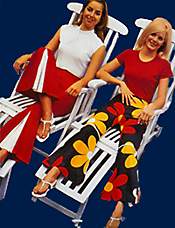
Bell Bottoms & Jeans
Bell-bottom pants were a defining fashion statement of the 1960s and continued into the 1970s. These pants featured wide flared legs that started tapering from the knees downward. Bell bottoms were worn in both dressy and casual styles, making them a versatile choice for teens.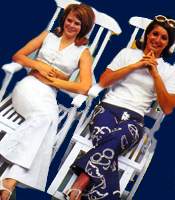
While jeans were not as ubiquitous in the 1960s as they are today, they were still worn, primarily for very casual activities. However, wearing jeans to places like the movies or shopping was not common. Jeans were typically reserved for the most informal occasions.
These teen models on either side are wearing Thermo-Jac Skinny Bones pants, the pant with the “Fabulous TJ fit.”
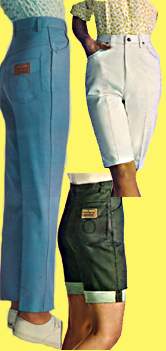
Montgomery Ward 1967All cotton denim cut the slim line way. Rider jeans $2.99Top – Sporty looking knee-cappers $2.79 Cuffed shorts – $2.49
Spiegel 1960 Shirt $1.94 Pants $3.94 Shoes $2.88
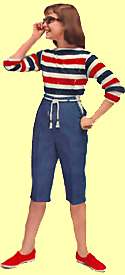
Overall, teen fashion in the 1960s was a mix of conservative school dress codes and the desire to express individuality and rebellion during social gatherings. The era witnessed shifts in hemlines, the popularity of bell bottoms, and the rise of hip huggers, all reflecting the changing attitudes and values of the youth culture during that transformative decade.
School and education fashion between teens in the 1960s was a reflection of the tension between societal expectations and the desire for self-expression. While many schools adhered to strict dress codes, requiring uniforms or modest attire, teenagers or students who even once got medical essays at EssayHub still found ways to assert their individuality through fashion. The struggle to balance personal style with academic conformity became a key part of the teen experience during this time.

We had a coat single breasted with vel velvet on collar. Brand?
Identifying a specific brand of coat from the 1960s based on a description of it being single-breasted with a velvet collar is quite challenging, especially given the wide range of fashion brands and styles prevalent during that era. Coats with velvet collars were a popular style in the 1960s and were produced by various fashion houses and designers.
If you have more details about the coat, such as a distinctive logo, pattern, or other unique features, that might help narrow down the search. Additionally, knowing the country of origin or any labels that might have been on the coat could also be useful. Without more specific information, it’s difficult to pinpoint a particular brand.
Love Thiss!!!!